A visit to Andersonville National Historic Site, including the National POW Museum, Confederate Prison Camp Sumter, and Andersonville National Cemetery.

Table of Contents
Andersonville: The Civil War in Georgia
I don’t recall when I first learned about Andersonville, the infamous Confederate prison in South Georgia, but it must have been in history class or in a book I read as a teen or young adult. I do remember being fascinated with the history and wondering if I would ever be able to visit this historic location. Back in 2000, I went on a genealogical road trip from my home in Central Florida to Monroeville, Alabama. My journey took me through South Georgia, and as fate would have it, that was the first time I came face-to-face with the Andersonville National Historic Site. I have visited Andersonville twice since then, and every visit is a moving, yet educational experience. In fact, the Americus-Plains-Andersonville area has become our favorite South Georgia destination.
Note: If you are planning a trip to Andersonville, you might want to schedule it on a weekend so you can attend Jimmy Carter’s Sunday School class.

The Visitor Center upon arrival.
The Andersonville NHS actually comprises three sectors: the National Prisoner of War Museum, the site of Camp Sumter military prison, and the Andersonville National Cemetery. With so much to see and do, it would be wise to schedule at least a full morning or afternoon for your visit to do it justice.
National Prisoner of War Museum
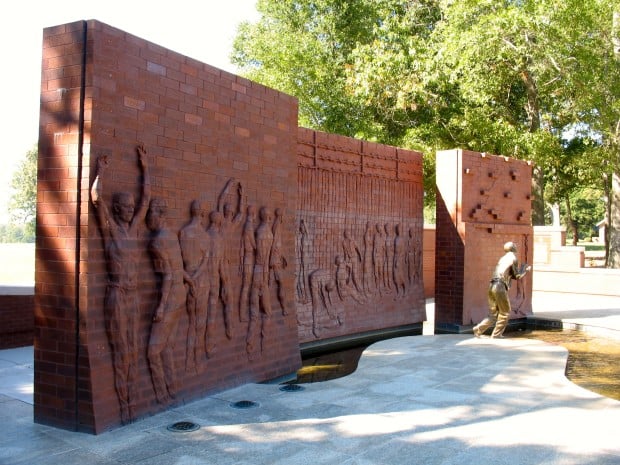
The National Prisoner of War Museum is housed in the same building with the Visitor Center and gift shop. Two introductory films about the Confederate prison at Andersonville and the prisoner of war experience in American history show on the half hour. The museum honors American POWs from all wars and explores the experience from the angles of “capture, living conditions, news and communications, those who wait, privation, morale and relationships, and escape and freedom.” Exiting the museum, visitors move into the courtyard and are confronted with the compelling memorial entitled “The Price of Freedom, Fully Paid,” which includes a water feature, three carved brick panels, and a bronze sculpture.
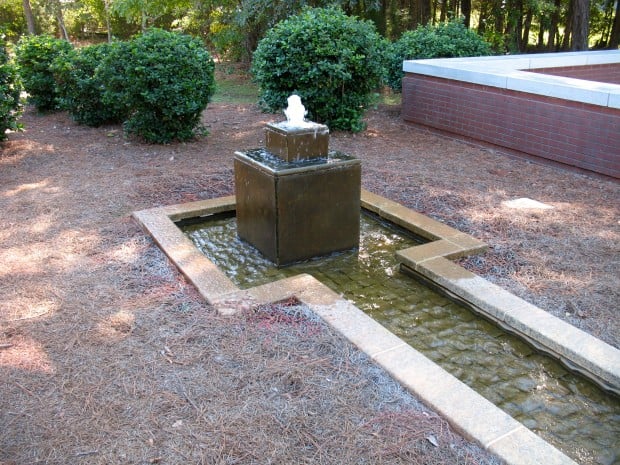
A fountain represents the essential importance of water for prisoners of war.

Water trickles from the hand of a grateful prisoner.

My National Parks Passport cancellations from Andersonville NHS.
Note: Before you leave the Visitor Center, be sure to collect your National Park Passport stamps at the front desk. This year special stamps marking the 150th anniversary of both the prison and cemetery are available. You can learn more about the National Parks Passport here.
Camp Sumter Military Prison Site

Photo Credit: Library of Congress, Prints and Photographs Division
Camp Sumter, also known as Andersonville Prison, opened in February of 1864. The site had been selected due to its proximity to the tiny village of Andersonville Station, a stop on the Southwestern Railroad. The rectangular stockade built by local slave labor eventually enlarged to encompass 26.5 acres. Originally built to hold up to 10,000 men, at one point the camp population swelled to 32,000 Union prisoners of war. Prisoners were forced to build their own shelters called “shebangs” from sticks and old army blankets and scraps of cloth. Of the 45,000 POWs ultimately imprisoned in the camp, nearly 13,000 died of malnutrition, dehydration, and disease from the extreme unsanitary living conditions.
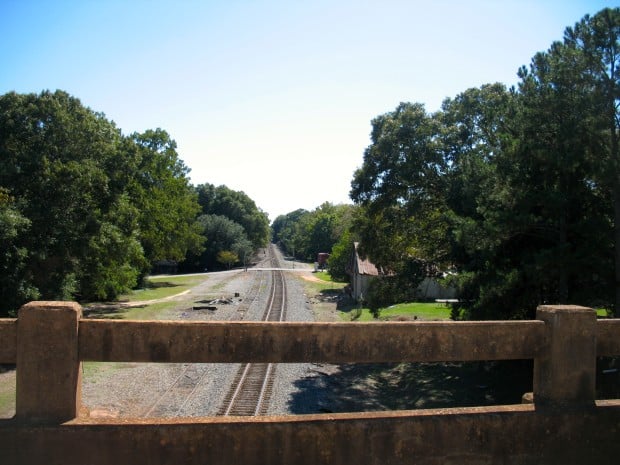
The railroad that ran through Andersonville Station as it looks today.
Soon after the opening of Camp Sumter, several prisoners managed to escape the camp by scaling the stockade wall with a cloth-woven rope. To discourage escape attempts, slaves were brought in to construct a light fence that became the “dead-line” nineteen feet inside the perimeter of the prison stockade. Prisoners were warned that anyone who crossed or touched this fence would be shot on the spot. The next day a German-born Union soldier who reached past the dead-line to retrieve a piece of cloth became the first casualty. Cruel guards who manned the sentry boxes, called “pigeon roosts” by the prisoners, would play sick games, tossing bits of food into the camp to watch the men scramble, or beyond the dead-line for target practice. Local citizens were invited into the pigeon roosts to observe the camp, a perverted form of entertainment.
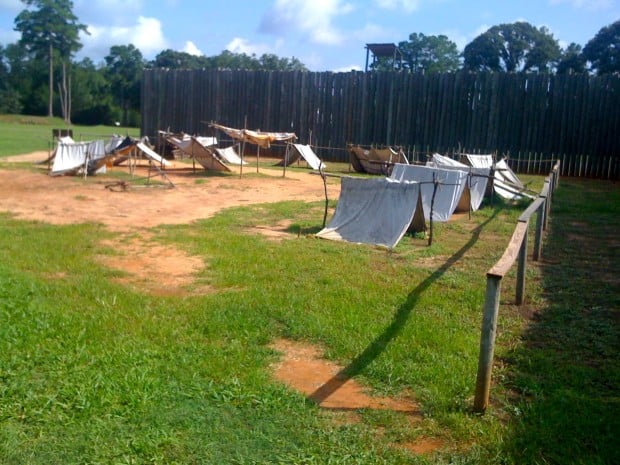
“Shebangs”

A reconstructed corner of the stockade, showing a pigeon roost and the dead-line.
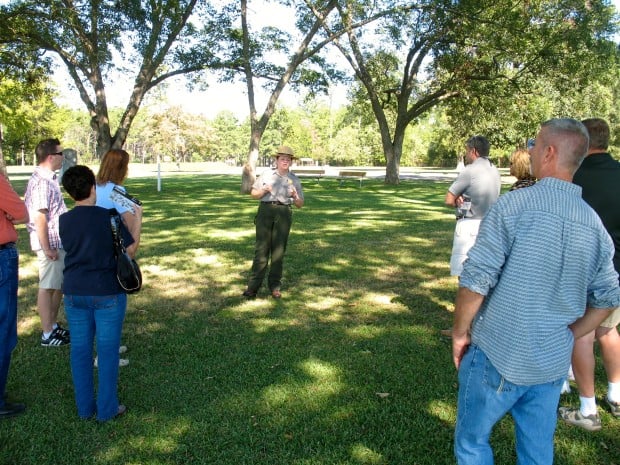
The ranger-led tour.
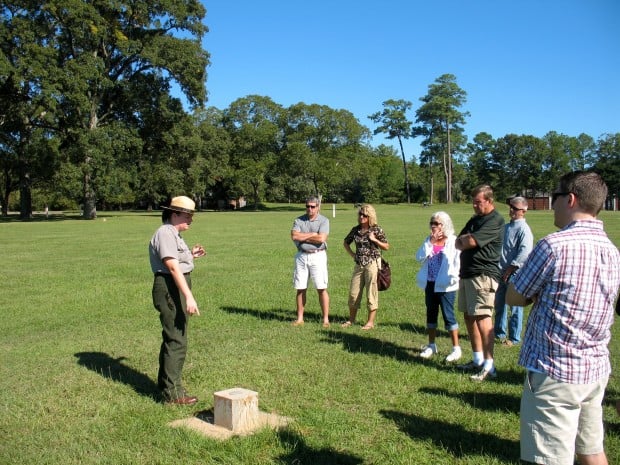
Concrete markers indicate sites where prisoners dug tunnels for escape or for water.
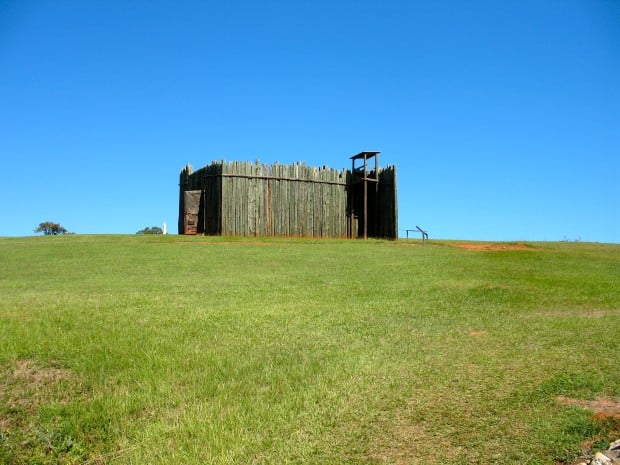
The reconstructed North Gate and stockade.

The Providence Spring House.
In answer to the prisoners’ prayers for fresh water, a miracle occurred on August 14, 1864. A bolt of lightning struck the hillside just beyond the dead-line and water suddenly gushed from the earth. John L. Maile, a prisoner from the 8th Michigan Infantry later wrote,
” . . . a spring of purest crystal water, which shot up into the air in a column and, falling in a fanlike spray, came babbling down the grade into the noxious Stockade Creek. Looking across the dead-line, we beheld with wandering eyes and grateful hearts the fountain spring.”
The commemorative Providence Spring House was built on the site and dedicated on Memorial Day in 1901.

Water still flows from Providence Spring.

The North Gate stockade and Providence Spring in perspective.

Rows of white posts mark locations of the stockade and dead-line in the distance.
Andersonville National Cemetery
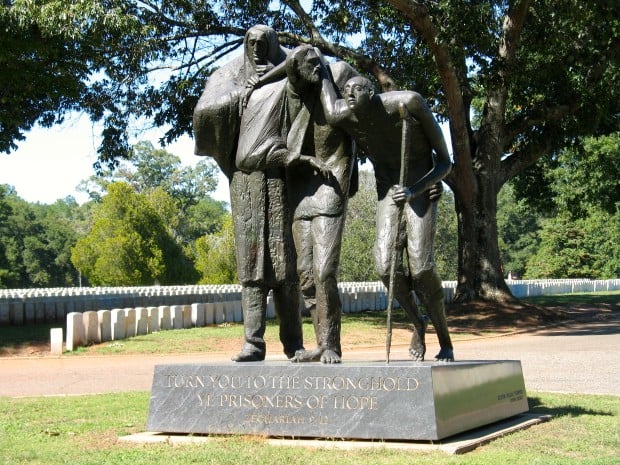
“Turn you to the strong hold, ye prisoners of hope . . . .” Zechariah 9:12
Statue at entrance to Andersonville National Cemetery
Nearly 13,000 Union soldiers who perished in Camp Sumter were laid to rest shoulder-to-shoulder in trenches within a section of hallowed ground that would become the Andersonville National Cemetery. Over the years, the cemetery has become the final resting place for many other American veterans, spouses, and their children.

A drive through the cemetery.
By June of 1864, an organized gang known as the Raiders were terrorizing the camp population, robbing and murdering other prisoners even in broad daylight. To combat the evil-doers, another group of prisoners called the Regulators organized and, authorized by prison officials, began to enforce laws in the camp. Although dozens of gang members were arrested, tried, and convicted in a court-martial, only six of the most notorious Raiders were executed by hanging on a Regulator-constructed gallows. They were buried in a remote section of the cemetery, unworthy to be buried with their fellow prisoners.
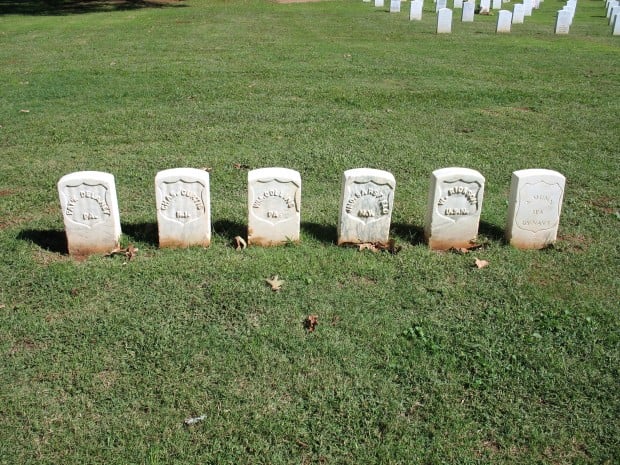
Graves of the executed Raiders.

The Raiders’ graves in perspective.
After the war, in response to thousands of letters from families inquiring about missing loved ones, Clara Barton, the “Angel of the Battlefield,” went on a mission to mark the graves of Union soldiers buried at Andersonville. She was aided by Dorence Atwater, a former prisoner who had been charged with maintaining death records at the camp hospital. Fearing that the official copy would never be turned over to government officials, Atwater had secretly kept a personal copy of the records and smuggled them out of the camp upon his release. Due to the work of Barton and Atwater approximately ninety-five percent of the Union soldiers’ graves were identified and marked.

Clara Barton and Dorence Atwater
Educate Yourself
I love to read books in preparation for my travels, but it seems I do less of it these days because I spend so much time writing. If you plan to schedule a visit to the Andersonville NHS and you don’t have much time to read up on the history, be sure to check-out a copy of the Andersonville DVD from your public library and watch it before you go. Even though it is a television mini-series, it is very well done, and it will give you a bit of background knowledge and a frame of reference for your visit. The PDF documents listed in the Helpful Links below are informative quick reads that will also help build your Andersonville schema.

We Would Love to Hear From You
Jerry and I enjoy dialogue with our readers, especially when they share travel stories from around the world. Have you visited a Civl War battleground or other National Historic Site? If so, we would love to hear about your experience! We invite you to leave your comments and questions below, and we always respond!
Map It!
Pin this Post!
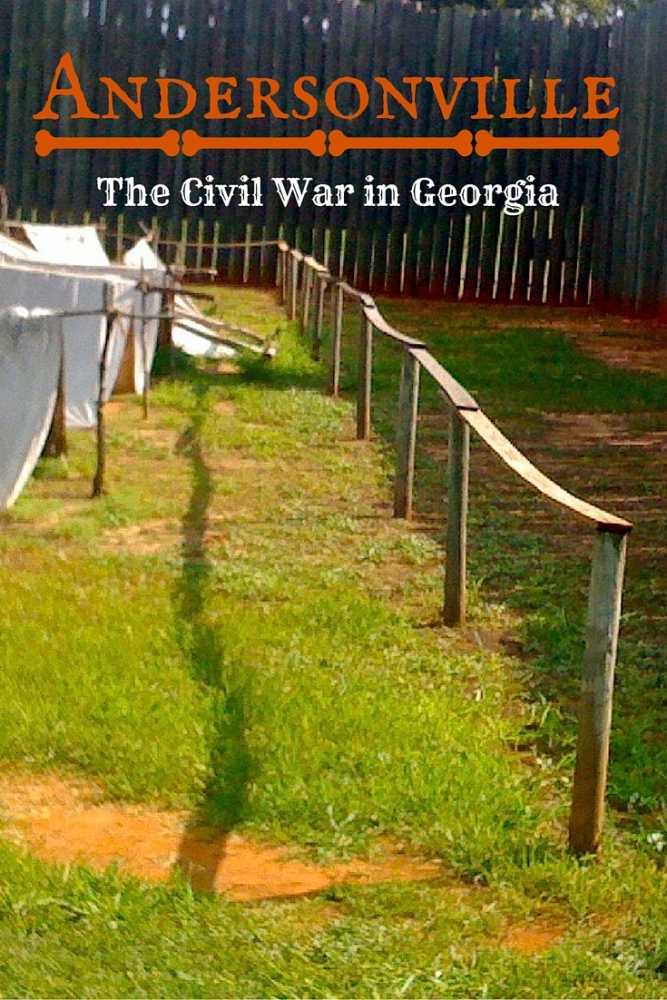
Helpful Links
Andersonville National Historic Site
Andersonville NPS Unigrid (PDF)
National Prisoner of War Museum Brochure (PDF)
Program from Dedication of the National POW Museum (PDF)
Clara Barton at Andersonville (PDF)



The very first movie I was in, and I did stuntwork in TNT’s Andersonville miniseries. John Frankenheimer won an Emmy for directing it. It was my first of 55 films.
Very cool! Thanks for stopping by Backroad Planet and sharing this background information.
Saw the movie and visited Andersonville. It was very touching.
I agree, Patricia. Always a moving experience.
What an awesome article! Thank you for the links to read up on before I visit. I LOVE doing that!
Glad to help, Kaaren!
Great post guys. I love the outdoor element of the Prisoner of War Museum. It’s so scary to think that people could treat their fellow citizen prisoners so cruelly, though I guess the Stanford prison experiment proved how possible that is. If you’re ever in Hungary, you might like to check out the House of Terror in Budapest – it’s very informative with some great propaganda and eye-witness footage from the Nazi and Soviet regimes.
Civil War memorial sites and battlefields have always intrigued me, nice shots!
Me, too, Raphael! Glad I got some good shots with my point-and-shoot and iPhone. I seriously want to get a “good” camera and start learning photography.
Howard, this is a very informative post. I didn’t know much about the Civil War -except what one can glean from movies- until we moved to Texas. It is interesting to see the Civil War memorials in every town, though I haven’t found one in Dallas yet. I’ll keep looking. The biggest one is probably the one outside the State Capitol in Austin.
On a sadder note, it never ceases to amaze me how cruel humans can be.
I did not realize there were that many Civil War battles in Texas, Ana! Thanks for the heads up . . . .
We travel through Georgia multiple times per year and have not stopped at the Andersonville National Historic Site. This is definitely somewhere we need to visit during our next trip. My son is a little history buff, so we are always looking for new places to take him.
You definitely need to visit Andersonville, Dana, and while you’re at it you should attend Jimmy Carter’s Sunday School Class that is only about twenty miles away.
This is a great overview on a part of one of our nation’s darkest times.
Thanks, Brianna!
I have never heard of this before but I would love to visit when I return back to the States. I am completely fascinated by anything related to US-history, particularly the Civil War. It’s so interesting!
Georgia is full of Civil War history, Sky! When you visit you will have enough to keep you busy for a while.
The work of Clara Barton and Dorence Atwater was amazing. I’m sure the families of the prisoners really appreciated it. It’s always interesting to learn how people can go out of their way to help in any way they can.
I agree, Vicky! Clara and Dorence were amazing selfless people, and their story adds yet another compassionate dimension to the hell that was Andersonville.
There is so much I learnt from this post! And those national park passports are such a cute idea, I absolutely love it! I wish we had something like this in India!
Thank you, Revati! The National Park Passports are wonderful. I have one for Florida State Parks, as well, and when I was in Canada, I found one for their national parks in the Maritime Provinces. I wish there were a passport for UNESCO World Heritage sites
This is such an important representation of a pivotal period in our nation’s history. I remember reading the book “Andersonville” years ago and being absolutely horrified, heartbroken and overwhelmed. Thanks for taking us along on this tour.
Thanks for reminding me of the book, Betsy! I should probably read it . . . . 🙂
I am all for history! I am also very interested in anything that relates to war or whatnot; not because I condone it, certainly not, but mainly because there’s so many things to learn from it (one of which is to try at the very best to never have one, ever again).
I honestly don’t have much idea of this war, so it’s a good thing that you’ve filled me in. And the links are very helpful as well! One of the things I do however, is not to read too much into things, because I want to be surprised once I visit the place. I often do the thorough researching afterwards. It doesn’t work for everybody but it works for me haha!
I agree with you, Aileen! I am never quite sure how much information to put in a blog post about destinations, historical or otherwise. I don’t want to be a spoiler and include too much content, but on the other hand I want to be sure there are enough details to generally inform the reader. I am dealing with this issue even now for the post I am currently writing. Thanks for your input!